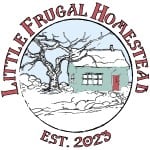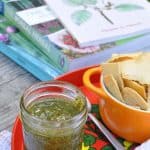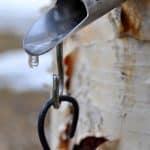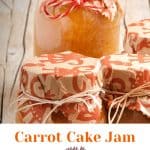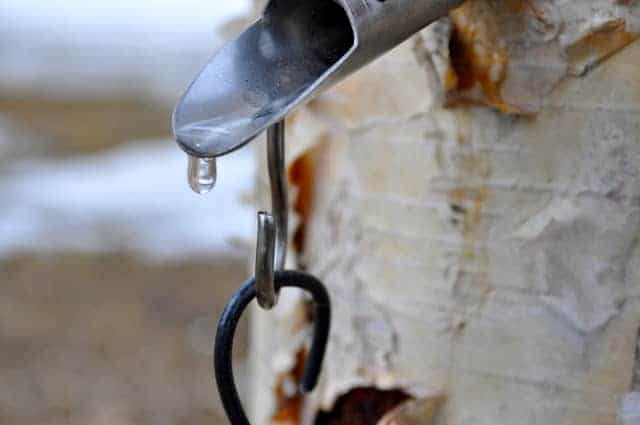How to Water Bath Can
Hot water bath canning is a popular method of preserving high-acid foods such as jams, jellies, pickles and tomatoes. You can fill your pantry with home-canned goods to feed your family all year ‘round with a bit of work and the right tools. Ready to learn how to water bath can? Let’s do it!

Be sure you only water-bath can foods that are high in acid or that are high in sugar. Items such as jam or jelly, pickles, or salsa. Do not water bath can low-acid foods like meat or plain vegetables. Those kinds of foods must be processed in a pressure canner and not in a hot water bath.
Small Batch Quick Recipes
If you want to make a small batch of pickles or jam to put right in the fridge, you don’t need to water bath can those jars. Check out this guide to quick pickle vegetables. They’re tasty and require zero canning.
Tools needed for hot water bath canning:
- a large pot with a lid that is tall enough to immerse your jars in water fully
- a canning rack or a towel to place at the bottom of the pot
- jar lifter
- canning funnel
- ladle
- bubble remover tool
- saucepan for heating lids
- magnetic lid wand
- plenty of clean kitchen towels
- paper towels
- jars with flat lids and bands
“I started water bath canning when we moved to the far north as a way to preserve our garden produce for the long winters. And although I love to experiment in the kitchen, I follow the rules when it comes to water bath canning! I make sure my jars are clean and not cracked, I follow the recipe carefully, and I leave enough headspace in each jar. And by the way, The Ball’s Book of Canning and Preserving is a great book for beginners.”
— Sarita Harbour, An Off Grid Life
Hot Water Bath Canning
These are the steps to can foods with a hot water bath:
- Prepare the equipment: Wash everything in hot soapy water and let it drip dry on clean dish towels. You can skip this step and use your dishwasher on a sanitizer load to clean and sanitize your tools. Even doing this the night before will work as long as they stay clean.
- Clean and sterilize your jars: Wash your jars and lids in hot, soapy water and rinse them well. Put the jars in a large pot of boiling water and let them simmer for at least 10 minutes to sterilize them.
- After sterilization: Keep jars warm. You can keep them full of hot water until you fill them with hot jelly or put them in a roasting pan oven on low heat to stay warm or utilize the dishwasher to keep them hot.
- Fill a saucepan with water and drop in the flat lids. Set the pan over low heat to keep the lids hot; don’t boil them
- Boil water: Fill the canning kettle with water, cover it, and bring it to a boil. Once boiling, reduce the heat to a simmer. Keep hot. Use a jar rack OR a towel in the bottom of the pan to keep the jars from rattling around and breaking in the canner.
- Prepare your food: Follow the recipe to prepare your food for canning. Fill hot jars using the canning funnel. Leave headspace as indicated by the recipe. The proper headspace is crucial for proper canning and storage of canned goods.
- Remove air bubbles: Use the bubble remover tool or knife to remove any air bubbles from the jar. This helps prevent spoilage and ensures a proper seal.
- Wipe the rim and place the lid: Use a clean, damp paper towel to wipe the rim of the jar to ensure a clean seal. Place a warm flat lid on top of the jar, and screw on the band until it is snug but not too tight. Do not over-tighten the jar lids.
- Place jars in the canning pot: Place the filled and closed jars into the canning rack or onto the towel in the pot of hot water. The jars should be fully submerged in water, and there should be at least 2 inches of water above the jars.
- Return the water to a boil: Cover the pot with the lid and bring the water back up to a rolling boil. Once boiling, start the timer according to your recipe. Be sure to keep the water boiling for the entire time.
- Remove jars from the pot: When the timer has gone off, turn off the heat and carefully use the jar tongs to remove the jars from the pot. Set the jars on a folded, clean towel in an out-of-the-way place where they won’t be disturbed.
- Let the jars cool: Do not touch the jars as they cool. This can create a “false seal” on the jars, giving space for spoilage to get started. This is truly the hardest part. Give them 24 hours to rest.
- Listen for the pop: As the jars cool, the flat lids will be sucked down and make a large pop sound. It’s what they should do. It’s music to a home canner’s ears! I love to hear my canning jars popping as they seal.
- Check the seals: After 24 hours, you can check the seal. Press down on the center of the lid. If the lid moves, the seal is not tight, and the food is not properly preserved. That doesn’t mean the food in the jar is not good to eat. You need to put it in the fridge. The seal is good if the lid is pulled down snugly onto the jar. Store any unsealed jars in the fridge and consume within a few weeks. My kids are always thrilled when we have a few jars of jam or jelly they MUST eat right away.
- Storing your canned goods: You can store any properly canned goods in a cool, dark place. Remove the ring, save it to use later, and put the jar away in your pantry. Removing the rings is important because if the jar becomes unsealed, it will definitely show up in the pantry. A ring on a jar may not let you see spoilage immediately.

Hot Water Bath Canning
Equipment
- a large pot with a lid that is tall enough to immerse your jars in water fully
- a canning rack or a towel to place at the bottom of the pot
- jar lifter
- Canning Funnel
- bubble remover tool
- saucepan for heating lids
- magnetic lid wand
- plenty of clean kitchen towels
- paper towels
- jars with lids and bands
Instructions
- Prepare your equipment: Wash everything in hot soapy water and let drip dry on clean dish towels-or you can use a dishwasher to wash and dry everything.
- Clean and sterilize your jars: Wash your jars and lids in hot, soapy water and rinse them well. Then, place them in a large pot of boiling water and let them simmer for at least 10 minutes to sterilize them.
- After sterilization: Keep jars warm. You can keep them full of hot water until you fill with jelly, or put them in the oven on low heat in a roasting pan to stay as warm as possible.
- Fill a saucepan with water and drop in the flat lids, set them to stay warm but not boiling
- Boil water: Fill the large pot with water, cover and bring to a boil. Once boiling, reduce the heat to a simmer. Keep hot.
- Prepare your food: Follow the recipe to prepare your food. Fill hot jars using the canning funnel. Leave headspace as indicated in your recipe. The proper headspace is crucial for proper canning and storage of canned goods.
- Remove air bubbles: Use the bubble remover tool or knife to remove any air bubbles from the jar. This helps prevent spoilage and ensures a proper seal.
- Wipe the rim and place the lid: Use a clean, damp paper towel to wipe the rim of the jar to ensure a clean seal. Place a warm flat lid on top of the jar, and screw on the band until it is snug but not too tight. Do not over-tighten the jar lids.
- Place jars in the canning pot: Place the filled and closed jars into to the canning rack or onto the towel in the pot of hot water. The jars should be fully submerged in water, and there should be at least 2 inches of water above the jars.
- Return the water to a boil: Cover the pot with the lid and bring the water to back up to a rolling boil. Once boiling start the timer according to your recipe.
- Remove jars from the pot: When the timer has gone off, turn off the heat and use the jar lifter to remove the jars from the pot carefully. Set the jars on a folded clean towel in an out of the way place where they won’t be disturbed.
- Let the jars cool: Do not touch the jars as they cool this can create a “false seal” on the jars giving a space for spoilage to get started.
- Listen for the pop: As the jars cool the flat lids will be sucked down and make a large pop sound. It’s what they should do. It’s music to a home canner’s ears.
- Check the seals: After 24 hours, you can check the seal. Press down on the center of the lid. If the lid moves the seal is not tight and the food is not properly preserved. If the lid is pulled down snugly onto the jar, the seal is good. Store any unsealed jars in the fridge and consume within a few weeks.
- Storing your canned goods: You can store any properly canned goods in a cool dark place. Simply remove the ring and put the jar away.
“There’s nothing quite like the satisfaction you get from canning your own foods. Water bath canning is a simple process that allows you to stock your pantry with all kinds of fruits, relishes, jams, pickles, and salsas. Canning helps you preserve your own harvest, take advantage of seasonal sales, and cut down on food waste. And you have a whole host of gift options for every occasion!”
—Cery Norvelle, Bramble Wine Cottage
Hot water bath canning is an easy and affordable way to preserve your favorite foods and get you started on your homesteading journey. It’s important to follow safety guidelines to prevent any contamination or spoilage. Always use tested recipes and follow your specific food’s recommended processing times and headspace. Happy canning!
